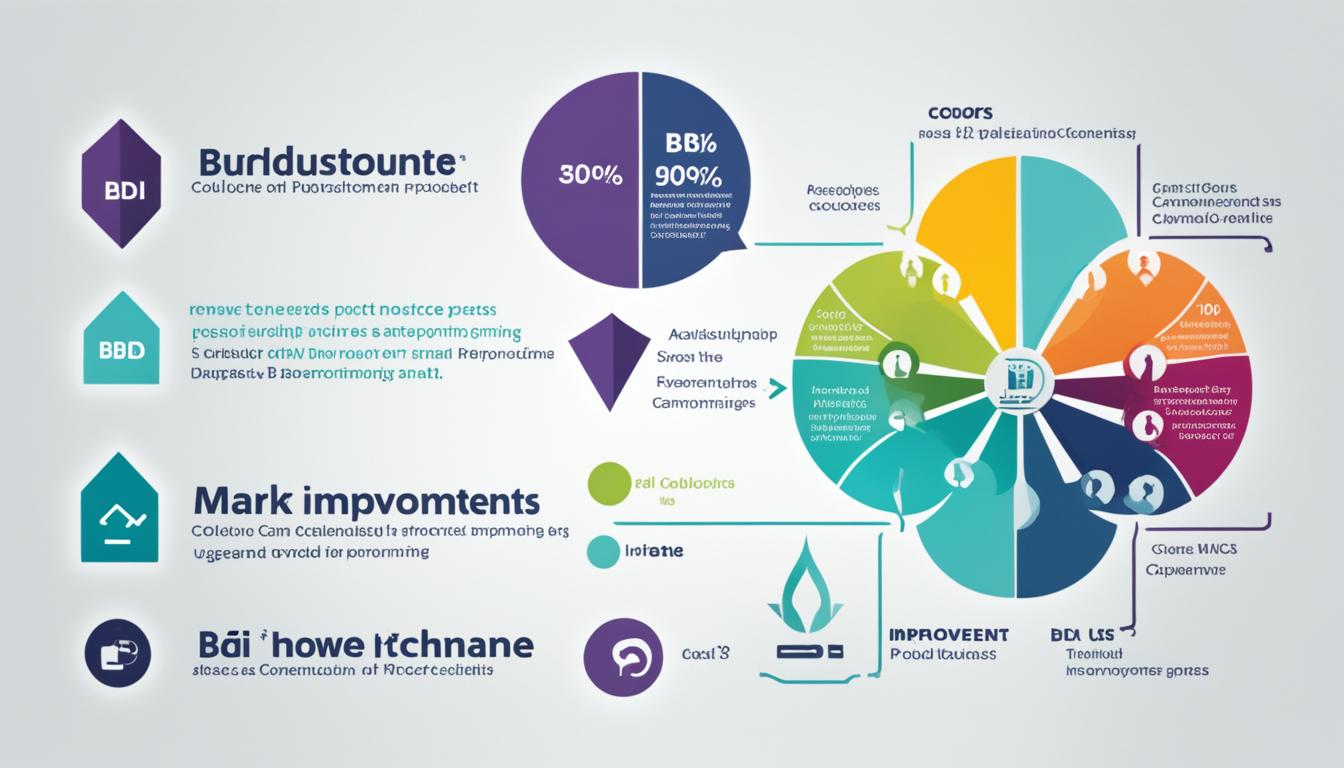As WestJet Airlines continues to navigate the ever-changing landscape of the aviation industry, its marketing strategy plays a crucial role in driving growth and maintaining its position as a key player in the market. In this case study, we will delve into WestJet’s innovative approach to marketing and explore the tactics that have propelled its success.
WestJet Airlines understands the importance of a well-crafted marketing strategy, especially in the highly competitive world of airline marketing. In recent years, while facing challenges brought on by Canada’s economic downturn, the company has been able to achieve consistent revenue growth. However, to maintain this momentum, WestJet needs new and effective ways to reach its target audience.
With a limited budget for expanding its social media presence, WestJet must make strategic decisions regarding which platforms to invest in. Two options that have been considered are Snapchat and Pinterest. As the company seeks to engage and connect with customers, it must choose the platform that best aligns with its objectives and budget constraints.
In the following sections, we will examine the importance of customer service in WestJet’s marketing strategy, revenue support as a key factor in their decision-making process, and evaluate the competitive landscape in the Canadian aviation industry. We will also explore WestJet’s approach to employee treatment and its impact on company performance, as well as the company’s journey in establishing a strong social media presence and the potential of Snapchat and Pinterest as marketing platforms.
By analyzing WestJet’s marketing strategy and the various elements that contribute to its success, we can gain valuable insights into the airline industry and its evolving landscape. Join us as we dissect WestJet’s approach and uncover the strategies that have propelled the company forward.
Key Takeaways:
- WestJet Airlines’ marketing strategy is crucial for driving growth in a competitive airline market.
- The company faces challenges in reaching its target audience while managing a limited budget for social media expansion.
- Customer service plays a vital role in WestJet’s marketing strategy, with a focus on engaging and supporting customers through social media platforms.
- Revenue support is a key factor in WestJet’s decision-making process when choosing a social media platform.
- The competitive landscape in the Canadian aviation industry presents challenges and opportunities for WestJet and its competitors.
The Importance of Customer Service in WestJet’s Marketing Strategy
As WestJet Airlines continues to expand its reach and attract a broader customer base, the company recognizes the significance of customer service in its overall marketing strategy. Social media platforms like Facebook and Twitter have enabled WestJet to engage directly with its customers, providing real-time support for bookings and inquiries.
By leveraging these social media channels, WestJet has been able to build strong relationships with its customers, addressing their needs promptly and effectively. This commitment to exceptional customer service has not only improved customer satisfaction but has also played a significant role in driving the airline’s growth.
WestJet understands that customer service is more than just responding to questions and concerns. It is an opportunity to showcase the company’s commitment to its customers, demonstrating a genuine desire to provide the best travel experience possible.
The Benefits of Exceptional Customer Service
Exceptional customer service offers several benefits to WestJet Airlines. Firstly, it helps to create a positive brand image, establishing WestJet as a customer-centric airline that values and prioritizes its passengers. Customers who experience exemplary service are more likely to become loyal advocates for the brand, spreading positive word-of-mouth and recommending WestJet to their friends and family.
Moreover, exceptional customer service can lead to increased customer loyalty and repeat business. When customers feel valued and well taken care of, they are more likely to choose WestJet for their future travel needs. This repeat business not only contributes to the airline’s revenue but also helps to establish a strong customer base in a highly competitive industry.
Going Above and Beyond
WestJet recognizes that delivering exceptional customer service goes beyond simply meeting customer expectations. The airline aims to exceed those expectations by proactively anticipating customer needs and finding innovative ways to enhance the travel experience. Whether it’s providing personalized recommendations, offering surprise upgrades, or anticipating and resolving issues before they become problems, going above and beyond is ingrained in WestJet’s customer service culture.
This commitment to exceptional customer service aligns with WestJet’s broader marketing strategy, creating a positive brand reputation and fostering long-term customer loyalty. By prioritizing customer service at every touchpoint, WestJet Airlines solidifies its position as a customer-centric airline, elevating the overall travel experience for its passengers.
Revenue Support in WestJet’s Marketing Strategy
As WestJet Airlines looks to expand its reach and grow revenue, the airline recognizes the importance of revenue support in its marketing strategy. In order to promote ads and generate direct booking options, WestJet needs to carefully consider the social media platforms it utilizes.
Choosing the right platform for revenue support is a critical decision for WestJet. By selecting a platform with a high user engagement rate and targeting options, the airline can effectively reach its target audience and drive revenue growth.
Factors to Consider in Selecting a Social Media Platform:
- User base: The size and demographics of the platform’s user base should align with WestJet’s target audience.
- Engagement rate: The platform should have a high engagement rate to ensure that WestJet’s ads and promotions are seen and interacted with by users.
- Targeting options: The platform should offer advanced targeting options, allowing WestJet to reach specific segments of its audience with tailored messages.
Considering these factors, WestJet might opt for popular platforms like Facebook or Instagram, which have large user bases and robust advertising features. Alternatively, they may choose platforms like LinkedIn or Twitter to target specific business travelers or engage with customers in real-time.
It is also worth exploring emerging platforms such as TikTok, which has gained significant popularity among younger audiences.
| Social Media Platform | Advantages | Disadvantages |
|---|---|---|
| Large user base, robust advertising features | High competition, potential for ad fatigue among users | |
| Visual-focused platform, high engagement rate | Increasingly saturated with sponsored content | |
| Business-oriented audience, targeting options for business travelers | Smaller user base compared to other platforms | |
| Real-time engagement with customers, trending topics | Limitation on character count for messaging | |
| TikTok | Highly popular among younger audiences, potential for viral content | Relatively new platform, less advertising options |
The Competitive Landscape in the Canadian Aviation Industry
Within the Canadian aviation industry, many airlines have encountered significant challenges, leading to closures and setbacks. Factors such as high labor costs and intense competition have posed obstacles to sustained success. However, WestJet Airlines and Air Canada have emerged as notable exceptions, demonstrating their ability to navigate these difficulties and maintain strong operations.
One of the key factors contributing to the success of WestJet and Air Canada is their adaptability to economic fluctuations. These airlines have implemented effective strategies to mitigate the impact of volatile market conditions and ensure continued growth. By proactively adjusting their operations and offerings, they have been able to withstand the challenges that have affected other airlines in the industry.
Additionally, WestJet and Air Canada have pursued cost-reduction strategies to enhance their competitive edge. By carefully managing expenses and optimizing resource allocation, these airlines have positioned themselves favorably within the Canadian aviation market. This acute focus on cost efficiency has allowed them to offer competitive prices without compromising on service quality.
The ability of WestJet and Air Canada to thrive amidst the competitive landscape of the Canadian aviation industry showcases their resilience and strategic acumen. These airlines have consistently demonstrated their commitment to providing exceptional customer service, maintaining operational efficiency, and adapting to market dynamics.
| Airline | Stability | Adaptability | Cost-Reduction Strategies |
|---|---|---|---|
| WestJet Airlines | High | Strong | Implemented |
| Air Canada | High | Robust | Emphasized |
The table above provides a comparative analysis of the stability, adaptability, and cost-reduction strategies implemented by WestJet Airlines and Air Canada. It further underscores their resilience in the face of challenges and their strategic focus on maintaining a strong position within the industry.
WestJet’s Employee Treatment and Performance
WestJet Airlines is known for prioritizing the well-being of its employees and maintaining a positive work environment. The company recognizes the value of treating their staff with respect and providing fair compensation, which contributes to their overall performance. WestJet has been acknowledged as an attractive employer, receiving awards for their commitment to employee satisfaction.
One of the ways WestJet demonstrates their appreciation for their workforce is through the provision of benefits such as share purchase programs and profit sharing. These initiatives create a sense of ownership and shared success among employees, motivating them to excel in their roles and contribute to the company’s growth.
Employee satisfaction plays a crucial role in WestJet’s success. By valuing their employees and fostering a supportive work culture, the company cultivates a motivated and engaged workforce. This, in turn, translates into higher productivity and customer satisfaction, positively impacting WestJet’s overall performance.
Employee Satisfaction Initiatives at WestJet
WestJet has implemented various programs to ensure the well-being of its employees and foster a positive work environment. These initiatives include:
- Maintaining competitive salary and benefits packages
- Providing opportunities for career growth and development
- Promoting work-life balance through flexible scheduling
- Encouraging open communication and feedback
- Supporting employee wellness programs
Through these initiatives, WestJet aims to create a supportive and inclusive workplace where employees feel valued, motivated, and empowered to deliver exceptional service to customers.
| Employee Treatment Programs at WestJet | Benefits |
|---|---|
| Share Purchase Programs | Allows employees to become stakeholders in the company |
| Profit Sharing | Enables employees to share in the company’s financial success |
| Competitive Salary and Benefits Packages | Ensures employees are fairly compensated for their work |
| Career Development Opportunities | Supports employee growth and advancement within the company |
| Flexible Scheduling | Promotes work-life balance and accommodates personal needs |
WestJet’s Journey in Establishing Social Media Presence
As WestJet Airlines adapted to the dynamic and highly competitive aviation sector, they recognized the significance of establishing a strong social media presence. With a focus on expanding their reach and maintaining their brand identity, WestJet embarked on a journey to increase their following on popular platforms like Pinterest and Snapchat.
In an industry where revenue volatility is a constant challenge, WestJet understood the importance of leveraging social media as a means to connect with their target audience. By harnessing the power of platforms such as Pinterest and Snapchat, they aimed to engage with customers in innovative ways while simultaneously managing the ups and downs of their financial performance.
Utilizing Pinterest: Showcasing Brand Identity
One of the social media platforms WestJet considered was Pinterest. With its visually appealing and highly shareable content format, Pinterest presented an opportunity for WestJet to showcase their brand identity and craft a compelling narrative. By curating boards that reflected their unique offerings, such as travel destinations and vacation inspirations, WestJet could captivate users and drive engagement.
In addition to visually appealing content, Pinterest allows businesses to link directly to their website, making it a valuable tool for driving traffic and generating leads. WestJet recognized the potential of this marketing platform to elevate their brand and reach a wider audience, thereby enhancing their social media presence.
Snapchat: Engaging with a Younger Audience
Another platform that WestJet explored was Snapchat, which has gained significant popularity among younger demographics. With its ephemeral and interactive nature, Snapchat provided WestJet with opportunities to create engaging content that resonated with their target audience.
Through Snapchat’s storytelling features, WestJet could share behind-the-scenes glimpses of their operations, exclusive offers, and interactive campaigns. By leveraging Snapchat’s unique capabilities, WestJet aimed to foster a sense of exclusivity and strengthen their brand’s connection with customers.
| Benefits of Pinterest | Benefits of Snapchat |
|---|---|
| Opportunity to showcase brand identity | Ability to engage with a younger audience |
| Visually appealing and shareable content format | Ephemeral nature creates a sense of exclusivity |
| Direct traffic to the WestJet website | Interactive features for engaging customer experiences |
By carefully analyzing the benefits of both Pinterest and Snapchat, WestJet aimed to strike a balance between showcasing their brand identity and engaging with their target audience. With a robust social media presence, WestJet would be well-equipped to navigate the competitive aviation landscape while staying true to their core values.
Evaluating Snapchat as a Marketing Platform for WestJet
Snapchat has become a popular social media platform, particularly among young adults. With its unique features and engaging content, it has created a large and active user base. However, many companies in the aviation industry have been hesitant to use Snapchat as a marketing platform.
Despite this hesitation, several airline companies have successfully utilized Snapchat to promote their products and services. By leveraging Snapchat’s interactive features, such as filters, stories, and geolocation tags, these companies have been able to engage with their target audience effectively.
WestJet Airlines can also benefit from utilizing Snapchat as a marketing platform. With its youthful demographic and extensive reach, Snapchat provides an opportunity for WestJet to showcase its brand and connect with its target audience. The platform’s emphasis on visual content allows for creative and captivating advertisements that can capture the attention of Snapchat users.
Furthermore, Snapchat’s ability to deliver personalized and real-time content can enhance WestJet’s customer experience by providing relevant and timely information. By leveraging Snapchat’s features, WestJet can interact with its customers, address their queries, and deliver tailored content that aligns with their preferences.
However, it is important for WestJet to carefully consider its advertising strategy on Snapchat. The platform’s ephemeral nature requires creating content that is engaging and captures the attention of users within a limited timeframe.
Snapchat Marketing Potential: Key Benefits
When evaluating Snapchat as a marketing platform, it is essential to consider its key benefits:
- Wide Audience Base: Snapchat has a large user base, particularly among young adults, providing WestJet with the opportunity to reach a significant portion of its target demographic.
- Engaging and Interactive Content: Snapchat’s unique features, such as augmented reality filters and interactive stories, enable WestJet to create captivating and interactive content that resonates with its audience.
- Real-Time Engagement: Snapchat’s direct messaging and story features allow WestJet to engage with customers in real-time, addressing their queries and providing timely information.
- Brand Awareness and Exposure: By leveraging Snapchat’s Discover section and sponsored lenses, WestJet can increase brand awareness and exposure to a wider audience.
- Influencer Collaborations: Snapchat provides opportunities for WestJet to collaborate with influencers and leverage their reach and influence to promote its products and services.
With careful planning, strategic content creation, and consistent engagement, WestJet can effectively utilize Snapchat as a marketing platform to enhance brand visibility, engage with its target audience, and drive business growth.
| Advantages of Snapchat as a Marketing Platform | Disadvantages of Snapchat as a Marketing Platform |
|---|---|
| Wide reach among young adults | Limited targeting options compared to other platforms |
| Engaging and interactive content features | Content lifespan limited to 24 hours |
| Real-time engagement with customers | Requires continuous content creation and storytelling |
| Opportunities for influencer collaborations | Less popular among older demographics |
Evaluating Pinterest as a Marketing Platform for WestJet
Pinterest is a popular and visually-driven social media platform with a significant number of active users. It has been widely embraced by many airline companies as an effective marketing platform, and WestJet Airlines can leverage its potential to showcase their business portfolios and engage with customers before they even interact with them.
Pinterest’s unique layout and focus on visual content make it an ideal platform for airlines to showcase their destinations, services, and travel experiences. WestJet can create captivating and inspiring boards that encompass the essence of their brand and engage users with stunning imagery and helpful travel tips.
By utilizing Pinterest, WestJet can tap into a diverse demographic, including individuals seeking travel inspiration, planning vacations, or looking for new experiences. The platform’s search functionality and categorization of content further enhance the chances of discovering WestJet’s offerings by relevant users.
Through strategic pinning and sharing of high-quality content, WestJet can build brand awareness, increase website traffic, and ultimately drive conversions. The visual appeal of Pinterest allows WestJet to capture users’ attention and spark their interest in exploring what the airline has to offer.
The Power of Inspirational and Informative Pins
Pinterest is an effective platform for WestJet to provide users with valuable travel-related content. By creating inspirational and informative pins, WestJet can establish themselves as a trusted resource in the travel industry. Pins showcasing breathtaking destinations, travel hacks, packing tips, and insider recommendations can entice users to engage with WestJet’s content, ultimately influencing their decision-making process.
In addition, Pinterest allows for seamless integration of shoppable pins, which enable users to directly purchase products or services from within the platform. WestJet can leverage this feature to promote flight deals, travel packages, and other offerings, providing users with a convenient and streamlined booking experience.
Engaging with a Captive Audience
One of the strengths of Pinterest is its highly engaged user base. Pinners spend significant time on the platform, actively searching for inspiration and planning future activities. By regularly posting captivating content and engaging with users through comments and replies, WestJet can foster a sense of community and build meaningful connections with their target audience.
Furthermore, Pinterest offers advertising options such as promoted pins and shopping ads, allowing WestJet to expand their reach and target specific demographics. Through strategic ad campaigns, WestJet can increase brand exposure, attract new customers, and foster loyalty among existing ones.
It is worth noting that while Pinterest has proven to be successful for many airlines, including WestJet’s competitors, it is crucial for WestJet to ensure that their Pinterest strategy aligns with their overall marketing goals. By consistently delivering high-quality and relevant content, WestJet can position itself as a leading airline brand on Pinterest and effectively leverage the platform to achieve its marketing objectives.
Considering a New Social Media Platform for WestJet
In addition to Snapchat and Pinterest, WestJet Airlines could also explore the opportunities presented by a new social media platform like TikTok. TikTok has gained tremendous popularity worldwide and offers a unique and engaging way for brands to connect with their target audience.
TikTok’s short-form video format allows WestJet to showcase its services, destinations, and customer experiences in a fun and creative manner. The platform’s algorithm-based content discovery system ensures that WestJet’s videos reach a wider audience and gain visibility.
By leveraging TikTok’s immense user base, WestJet can enhance its marketing strategy and make a stronger impact on potential customers. The platform’s interactive features, including challenges, filters, and effects, provide ample opportunities for creative storytelling and brand promotion.
Utilizing a new social media platform like TikTok can help WestJet Airlines stay at the forefront of the ever-evolving digital landscape and capture the attention of younger demographics. As TikTok continues to grow, integrating it into their marketing strategy can open up new avenues for WestJet to connect with Gen Z and millennial travelers.
Benefits of TikTok for WestJet Airlines
Embracing TikTok as a new social media platform offers several advantages for WestJet:
- The ability to reach a large and diverse audience: TikTok boasts over a billion active users worldwide, providing WestJet with an extensive pool of potential customers.
- Increased brand visibility: TikTok’s algorithm promotes content based on user interests, ensuring that WestJet’s videos reach users who are likely to engage with the brand.
- Creative storytelling opportunities: TikTok’s video editing tools and features allow WestJet to showcase its brand personality and unique offerings in a captivating and entertaining way.
- Opportunity to connect with younger demographics: TikTok is particularly popular among Gen Z and millennial audiences, enabling WestJet to establish a strong presence among these vital consumer groups.
Adopting a new social media platform like TikTok can revitalize WestJet Airlines’ marketing strategy, helping the company remain relevant and appealing to its target audience. By embracing the unique attributes of TikTok, WestJet can create engaging content that resonates with users and differentiates the airline from its competitors.
Execution of WestJet’s Social Media Strategy
Pinterest is recommended as the best fit for WestJet Airlines’ short and long-term social media goals. The chosen platform allows WestJet to showcase their brand identity and engage with their target audience effectively.
Why Pinterest?
Pinterest’s visual nature and user-friendly interface make it an ideal social media platform for WestJet’s marketing strategy. With its emphasis on visuals and inspiration, Pinterest provides the perfect opportunity for WestJet to showcase their travel destinations, products, and services in an appealing and inspiring manner.
By utilizing Pinterest’s innovative features, WestJet can create captivating and shareable content that resonates with their target audience. These features include:
- Rich pins: WestJet can use rich pins to provide detailed information about their products, such as flight details, pricing, and availability. This enables users to make informed decisions and increases the likelihood of bookings.
- Boards: WestJet can create boards to categorize their content and make it easily discoverable for users. By organizing content into themed boards, such as “Beach Getaways” or “Adventure Travel,” WestJet can cater to different customer preferences and inspire travel ideas.
- Collaborative boards: WestJet can leverage collaborative boards to engage with their audience and encourage user-generated content. This promotes a sense of community and allows customers to share their travel experiences, tips, and recommendations.
WestJet’s execution plan should focus on consistency and good quality. It is essential to maintain a powerful corporate voice across all social media channels and deliver content that aligns with the brand’s identity and values.
Success Criteria
The success of WestJet’s social media strategy on Pinterest can be determined by the following criteria:
- Increased engagement: WestJet should aim to foster meaningful interactions with their audience through likes, comments, and repins. This indicates that their content is resonating with users and generating interest.
- High-quality visual content: The visuals shared by WestJet should be visually appealing, well-crafted, and representative of their brand. This helps to capture the attention of users and differentiate WestJet from competitors.
- Long-lasting customer relations: WestJet should focus on building lasting relationships with their customers by responding to comments and inquiries promptly and providing exceptional customer service.
- Conversion rates: WestJet should track the number of bookings and conversions generated through their Pinterest strategy. This metric helps to measure the effectiveness of their social media efforts in driving tangible business outcomes.
To ensure success, WestJet should closely monitor these success criteria, regularly analyze performance metrics, and make data-driven adjustments to their social media strategy on Pinterest.
| Benefits of Using Pinterest for WestJet Airlines | Considerations |
|---|---|
| Pinterest’s visual nature allows WestJet to showcase their travel destinations and services effectively. | WestJet needs to create visually engaging and relevant content to stand out on Pinterest. |
| Pinterest has a large user base, providing WestJet with the opportunity to reach a wider audience. | WestJet must actively engage with their audience by responding to comments and inquiries to maintain a positive reputation. |
| Pinterest’s features, such as rich pins and collaborative boards, enhance WestJet’s ability to provide detailed information and foster community engagement. | WestJet needs to regularly update their Pinterest boards and maintain consistency in their content strategy. |
Conclusion
In conclusion, WestJet Airlines has recognized the significance of social media in their marketing strategy and has made efforts to expand their presence. By carefully evaluating platforms such as Snapchat and Pinterest, as well as considering new options like TikTok, WestJet aims to effectively reach their target audience and achieve their marketing objectives.
Consistency plays a pivotal role in WestJet’s marketing strategy, ensuring that their brand is effectively communicated across all social media platforms. Additionally, customer service remains a key focus for the airline, as they understand the importance of providing exceptional support and engagement to their customers throughout their journey, from inquiries to bookings.
Moreover, revenue support plays a vital role in WestJet’s marketing strategy. By utilizing social media platforms to promote advertisements and providing direct booking options, WestJet can generate revenue and enhance their overall marketing efforts.






